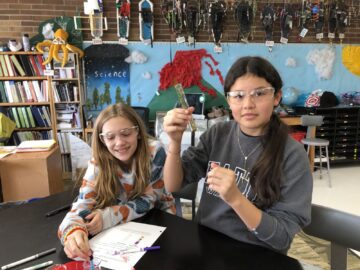Program Updates – Science & Math – October 2024

Science
6th: The 6th graders are wrapping up their study of how a hot air balloon takes off. Breaking a complex question into smaller bites is a great way to both answer the question and to develop an understanding of more complex concepts like density. It can be calculated mathematically (I’m looking at you, 8th graders), and the density of a substance can be understood simply in relation to another substance; is A more or less dense than B. Like a game of Mastermind or Wordle, students tried to discover the relative densities of 6 liquids by layering them in a test tube. We also blew out a candle by pouring the “invisible” CO2 that’s produced when baking soda and vinegar mix. So how does a hot air balloon take off? Ask a 6th grader.
7th: The 7th graders have been learning about an injury that happened to a middle school student that caused him to need stitches, pins, and a cast. They analyzed doctor reports to develop an initial model for what is happening in our body when it heals. Students are investigating what the different parts of our body are made of, from the macro scale to the micro-scale. They are figuring out parts of our body are made of cells and that these cells work together for our body to function. In the next few weeks, they will be investigating what happens when cells make more cells, what cells need to make more cells, and how cells get what they need to make more cells. Students will return to the healing timeline they made at the start of the unit and apply what they have learned about the interactions between the different systems in the body to explain the various events of healing that took place for the injury at the start of the unit. Finally, they will apply their model for healing to explain growth at growth plates in children’s bodies as they become adults.
8th: In 2024, we take for granted that the continents are drifting around on the surface of the Earth. One hundred years ago, that idea was heresy. Uncovering some of the evidence that got us to today’s understanding of The Theory of Plate Tectonics has been the work of 8th grade Earth Science students this year. While camping at Mt. Rainier, we saw current glaciers and evidence of glaciers that have since receded. Similar evidence on a much greater scale exists on Africa, S. America and the Indian subcontinent that proves the continents have moved. Other questions we’ve explored include how did locations above the Arctic Circle once have the kind of plant life necessary to form coal and how could identical 100 million year old animal fossils be found on continents 3,000 miles apart if those animals couldn’t swim. Now that we’re confident the continents are moving, we’re ready to tackle HOW they’re moving.

Math
6th: So far Math has been an effort to make the underpinnings of our base-ten system make sense: Place Value, Other Bases, Multiplying by Powers of Ten, Rounding, Scientific and Expanded and Exponential Notation, and the Beauty of the Metric System – all things rooted in base-ten. We began by considering how the Citizens of Planet Four (who group numbers into fours and sixteens and sixty-fours rather than tens, hundreds, and thousands) to help students comprehend the idea that our counting system is based on grouping of tens, and tens of tens, and tens of tens of tens, etc. Since then we have argued about which numbers “round up”, have talked about the kinds of numbers astronomers and atomic physicists might use, have walked multiple hectometers and converted other metric measures, and have tried to make sense of the way digits glide up and down the place values when multiplied and divided by powers of ten. Suffice it to say that it’s all been a little in-tens. 🙂 We also talked about ways to prepare for a math test. The Unit Test happens and then we analyze, repair, regroup and head for two-dimensional areas (which is really a lot of multiplying in disguise). Onward.
7th: In 7th grade math, we are finishing up our first unit on geometry. The students have been working in the coordinate plane, learning about rigid transformations. Students learn that any sequence of translations, rotations, and reflection s preserves angles and distances. Students experimentally verified the properties of translations, rotations, and reflections. They used these properties to reason about plane figures, understanding informal arguments showing that the alternate interior angles cut by a transversal have the same measure and that the sum of the angles in a triangle is 180 degrees. We will be using these skills to begin our transition into linear algebra.
8th: Algebra has begun with a focus on the core components of algebraic solution-finding: combining like terms (and not combining unlike ones), simplifying expressions, solving equations, evaluating possible solutions, and representing equations graphically. We used Algebra Tiles to represent solving for y in a variety of algebraic situations. We ”plugged in” values, testing whether or not they made equations (mathematical sentences) true and talked about what that looks like on a Cartesian Coordinate System (and how an ailing DesCartes may actually have come up with the idea of a two-dimensional graph.) The online Illustrative Mathematics textbook tricked me by updating their text and making the new text available at a different URL (apologies to those who spent inordinate amounts of time looking for things that had been rearranged), and I’d be happy to reorient folks to the new text, if you can’t find your way around it. It has a family section that may be useful, as well as student summaries and practice problems. Please talk to me soon about strategies for any students you think might be experiencing unproductive struggle. We need to get everyone on the Algebra train as quickly, comfortably, and productively as possible.

